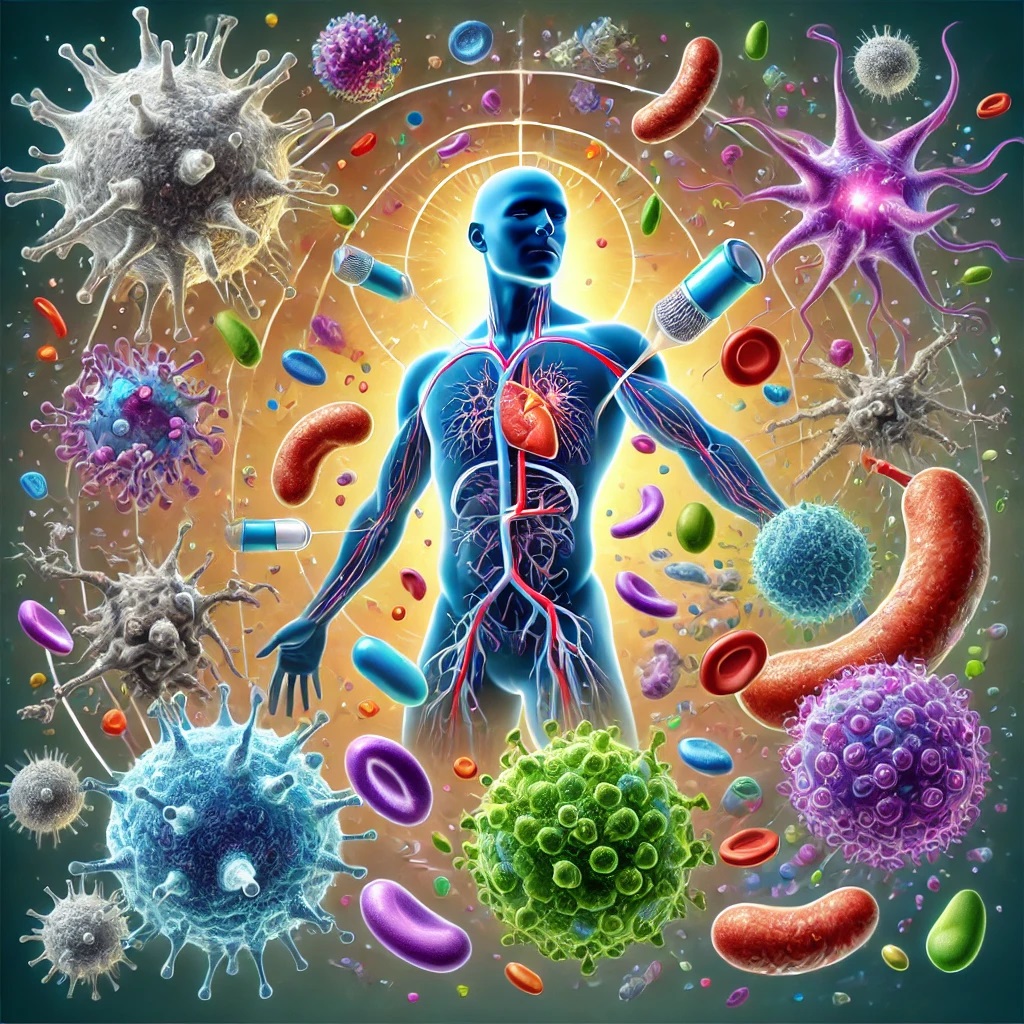
Immunity is the body’s ability to resist harmful microorganisms or pathogens, such as bacteria, viruses, fungi, and parasites. It is an essential aspect of human health and plays a pivotal role in defending against disease. The immune system is a complex network of cells, tissues, and organs that work together to protect the body from infections and diseases. Immunity can be innate or acquired, and it forms a critical component of overall health and disease resistance. In this article, we will explore the concept of immunity, the mechanisms involved in immune responses, and how the immune system works to defend against diseases.
1. What is Immunity?
Immunity refers to the ability of an organism to fight off or resist infections and diseases. The immune system is a sophisticated defense system that is capable of detecting and responding to harmful pathogens that enter the body. The immune system is divided into two main types: innate immunity and adaptive immunity.
- Innate Immunity: This is the body’s first line of defense and is present from birth. It is a non-specific response to pathogens and involves physical barriers such as skin, mucous membranes, and the internal defense mechanisms like phagocytes and natural killer cells.
- Adaptive Immunity: Also known as acquired immunity, it develops over time after exposure to specific pathogens. It involves the activation of specific immune cells like B lymphocytes and T lymphocytes, which produce antibodies and memory cells to target and neutralize specific pathogens.
2. The Immune System: Key Components
The immune system is made up of several key components, including:
2.1 White Blood Cells (Leukocytes)
White blood cells are crucial to immune responses and come in various forms, each with a specific function. These include:
- Phagocytes (Macrophages and Neutrophils): These cells engulf and digest pathogens, a process called phagocytosis. They are part of the innate immune system.
- B lymphocytes (B cells): B cells produce antibodies, which are proteins that recognize and neutralize specific pathogens. They are involved in the adaptive immune response.
- T lymphocytes (T cells): T cells regulate the immune response and directly attack infected cells. There are different types of T cells, including helper T cells and cytotoxic T cells.
2.2 Lymphatic System
The lymphatic system, which includes lymph nodes, spleen, and tonsils, is a network of vessels and tissues that carries lymph fluid containing white blood cells throughout the body. Lymph nodes filter harmful substances and activate immune responses.
2.3 Antibodies
Antibodies are proteins produced by B cells that recognize and bind to specific antigens (molecules found on the surface of pathogens). Antibodies neutralize pathogens by preventing them from infecting healthy cells or marking them for destruction by other immune cells.
3. Types of Immunity
Immunity can be classified into two broad categories: innate immunity and adaptive immunity.
3.1 Innate Immunity
Innate immunity provides immediate defense against infections. It is the body’s natural, nonspecific defense mechanism against a wide variety of pathogens. Key components of innate immunity include:
- Physical Barriers: The skin, mucous membranes, and respiratory tract are physical barriers that prevent pathogens from entering the body.
- Chemical Barriers: Substances like stomach acid, enzymes in saliva, and mucus act to destroy or trap invading pathogens.
- Phagocytosis: Specialized cells such as neutrophils and macrophages engulf and digest pathogens. This process is an essential part of the innate immune system.
- Inflammatory Response: When the body is infected, an inflammatory response occurs, which increases blood flow to the site of infection, helping to deliver immune cells to combat pathogens.
3.2 Adaptive Immunity
Adaptive immunity is more specific and involves the body’s ability to recognize and respond to particular pathogens. It is a slower response compared to innate immunity, but it has the ability to remember previous encounters with pathogens and provide long-lasting protection.
- Cell-Mediated Immunity: This involves T cells, which recognize infected cells and destroy them. Cytotoxic T cells attack infected cells, while helper T cells coordinate the immune response by stimulating B cells and other immune cells.
- Humoral Immunity: This involves B cells, which produce antibodies to target pathogens. Antibodies can neutralize pathogens, mark them for destruction, or prevent them from entering healthy cells.
4. How Does the Immune System Protect Against Disease?
The immune system functions through a complex sequence of events that enable it to defend the body against disease-causing agents. Below are the key processes that protect against diseases:
4.1 Recognition of Pathogens
The first step in the immune response is the recognition of pathogens. This is done by specialized immune cells called antigen-presenting cells (APCs), which include dendritic cells and macrophages. These cells capture pathogens and display pieces of the pathogen (antigens) on their surface, triggering an immune response.
4.2 Activation of Lymphocytes
Once a pathogen is recognized, it activates T cells and B cells. Helper T cells stimulate B cells to produce antibodies specific to the pathogen, while cytotoxic T cells kill infected cells. These cells undergo proliferation to produce large numbers of specific immune cells to fight the infection.
4.3 Antibody Production
B cells produce antibodies that recognize specific antigens on the surface of pathogens. These antibodies bind to the pathogen, marking it for destruction by other immune cells or preventing it from infecting healthy cells.
4.4 Memory Formation
One of the key features of adaptive immunity is the formation of memory cells. After an infection is cleared, some of the B and T cells remain in the body as memory cells. These cells “remember” the pathogen and are ready to respond more quickly and effectively if the body encounters the same pathogen again.
5. Types of Immunity in Humans
There are two types of immunity in humans: active immunity and passive immunity.
5.1 Active Immunity
Active immunity occurs when the body’s immune system produces its own antibodies in response to exposure to an antigen. This can happen naturally when the body is exposed to a pathogen, or artificially through vaccination.
- Natural Active Immunity: This occurs when a person is exposed to a disease-causing organism and the immune system responds by producing antibodies and memory cells.
- Artificial Active Immunity: This occurs through vaccination, where an individual is exposed to a weakened or inactivated form of a pathogen, stimulating the immune system to produce antibodies without causing disease.
5.2 Passive Immunity
Passive immunity occurs when a person receives antibodies from an external source. This provides immediate protection but does not result in memory cells.
- Natural Passive Immunity: This is provided to infants through the placenta or breast milk, which contains antibodies from the mother.
- Artificial Passive Immunity: This can be provided through antibody-containing blood products, such as immunoglobulin injections, for individuals who are exposed to certain diseases or toxins.
6. Disorders of the Immune System
While the immune system plays a crucial role in protecting the body from disease, there are certain conditions in which the immune system becomes compromised or dysfunctional. These include:
6.1 Immunodeficiency Diseases
Immunodeficiency diseases occur when the immune system is unable to mount an adequate defense against infections. These can be either congenital (present from birth) or acquired (develop later in life).
- Primary Immunodeficiencies: These are genetic conditions in which a part of the immune system is missing or underdeveloped. An example is Severe Combined Immunodeficiency (SCID), where both T cells and B cells are absent or nonfunctional.
- Acquired Immunodeficiencies: These occur due to external factors, such as HIV/AIDS, where the immune system is compromised by the virus.
6.2 Autoimmune Diseases
Autoimmune diseases occur when the immune system mistakenly targets and attacks the body’s own tissues. Common autoimmune diseases include rheumatoid arthritis, lupus, and multiple sclerosis.
6.3 Allergies
Allergic reactions occur when the immune system overreacts to harmless substances (allergens), such as pollen, pet dander, or certain foods. This leads to inflammation and symptoms like itching, swelling, and difficulty breathing.
Here are 10 questions with answers related to Immunity and the Body’s Defense Against Disease:
1. What is immunity?
Answer:
Immunity is the body’s ability to resist or fight off infections and diseases through the immune system. It involves a complex network of cells, tissues, and organs that work together to identify and destroy foreign invaders like bacteria, viruses, and parasites, as well as abnormal cells (e.g., cancerous cells). Immunity can be classified into two types: innate immunity (the body’s first line of defense) and adaptive immunity (the immune response that develops over time and provides long-term protection).
2. What are the two main types of immunity?
Answer:
The two main types of immunity are:
- Innate Immunity: This is the body’s natural defense that is present from birth. It provides an immediate, nonspecific response to infections. Components of innate immunity include physical barriers (like the skin), chemicals (such as antimicrobial proteins), and immune cells (like macrophages and neutrophils) that recognize and attack foreign invaders.
- Adaptive Immunity: This immunity is acquired over time through exposure to pathogens or through vaccination. It involves a specific response to pathogens, including the production of antibodies by B cells and the activation of T cells that help destroy infected cells. Adaptive immunity provides long-lasting protection and memory against specific pathogens.
3. What is the difference between active and passive immunity?
Answer:
- Active Immunity: This is immunity that develops when the immune system is exposed to a pathogen and produces antibodies or activated T cells to fight the infection. It can be acquired naturally (through infection) or artificially (through vaccination). Active immunity provides long-term protection.
- Passive Immunity: This type of immunity is acquired by receiving antibodies from another person or animal. It provides immediate protection but is short-lived because the body does not produce its own immune cells. Examples include maternal antibodies passed to a baby through breast milk or antibody treatments used in certain diseases.
4. How does the body recognize foreign pathogens?
Answer:
The body recognizes foreign pathogens through antigens, which are molecules found on the surface of pathogens like bacteria, viruses, and fungi. The immune system has specialized cells called antigen-presenting cells (APCs) such as dendritic cells and macrophages that identify and capture these antigens. These cells then present the antigens to other immune cells, such as T cells, which initiate an immune response to target and destroy the pathogens.
5. What is the role of white blood cells in immunity?
Answer:
White blood cells (WBCs) are critical to the immune system. There are several types of WBCs, each playing a distinct role:
- Neutrophils: The first responders to infection, attacking and engulfing pathogens.
- Macrophages: Large cells that engulf and digest foreign particles, dead cells, and pathogens. They also present antigens to T cells.
- B cells: Produce antibodies that specifically target and neutralize pathogens.
- T cells: Include helper T cells, which stimulate B cells and cytotoxic T cells, and cytotoxic T cells, which kill infected cells.
6. What is the role of antibodies in immunity?
Answer:
Antibodies are proteins produced by B cells in response to the presence of antigens. They bind specifically to these antigens, neutralizing pathogens and marking them for destruction by other immune cells. Antibodies can prevent viruses from entering cells, neutralize toxins, and help activate other parts of the immune system, such as complement proteins, which enhance immune responses. Antibodies also provide immunological memory, allowing the body to respond more effectively to future infections with the same pathogen.
7. What is the difference between the humoral and cellular immune response?
Answer:
- Humoral Immune Response: This is primarily mediated by B cells and antibodies. When B cells encounter a pathogen, they produce antibodies that circulate in the blood and lymph to neutralize or destroy the pathogen.
- Cellular Immune Response: This involves T cells, which directly attack infected cells. Cytotoxic T cells recognize and kill infected cells, while helper T cells assist in activating B cells and other immune cells.
Both responses work together to provide protection against infections.
8. What is an antigen and how does it stimulate an immune response?
Answer:
An antigen is a molecule or part of a molecule that triggers an immune response when recognized by the immune system. Antigens are typically found on the surface of pathogens (like bacteria, viruses, and fungi), but they can also be on cancerous cells or foreign substances like pollen. When the immune system encounters an antigen, antigen-presenting cells process and present it to T cells, which stimulate the production of B cells and antibodies, initiating an adaptive immune response to eliminate the pathogen.
9. What is immunological memory, and how does it protect the body?
Answer:
Immunological memory refers to the immune system’s ability to “remember” previous encounters with pathogens. After an initial infection or vaccination, the body creates memory B cells and T cells that are specific to that pathogen. If the body encounters the same pathogen again, these memory cells recognize it and trigger a faster and stronger immune response, often preventing the person from becoming sick or reducing the severity of the disease.
10. What are vaccines, and how do they help in the prevention of diseases?
Answer:
Vaccines are substances that stimulate the immune system to produce an immune response without causing disease. They typically contain weakened or inactivated forms of pathogens or pieces of the pathogen, such as proteins or antigens. When a person is vaccinated, their immune system recognizes the antigens and produces memory cells. If the person is later exposed to the actual pathogen, their immune system can quickly respond to eliminate the pathogen, thus preventing illness or reducing the severity of the disease.
These questions and answers provide an overview of how the body defends itself against diseases, the role of the immune system, and the mechanisms involved in immunity.






